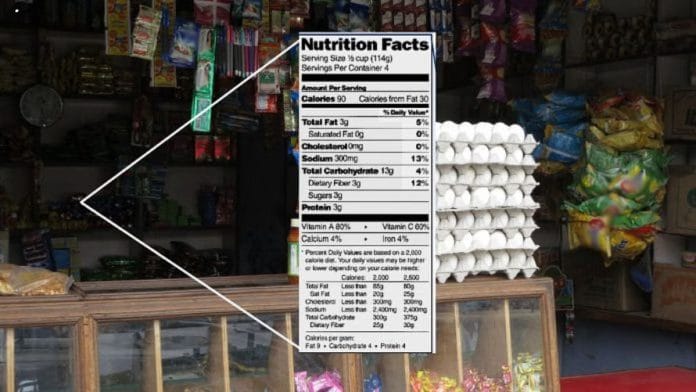New Delhi: A coalition of India’s 29 leading public health and consumer organisations gave a fresh call Tuesday to mandate front-of-pack warning labels on pre-packaged food and beverage products high in sugar, salt, and fat.
This follows a 12 April Supreme Court direction to an expert panel to come up with final recommendations within three months on introducing—for the first time in India—front-of-pack nutrition labelling (FOPNL) and amending food safety and standing norms accordingly.
The apex court’s directions were in response to a Public Interest Litigation (PIL) seeking judicial intervention to get front of pack warning labels mandated on all packaged food high in salt, sugar and fat, and all ultra-processed foods (UPF) such as chips, cookies, sweets, soft beverages, instant noodles, sugary cereals, frozen meals, ice cream, bakery items, and chocolates.
The expert panel under the Food Safety and Standard Authority of India (FSSAI) was set up after the food regulator floated in 2022, the first draft FOPNL policy proposing ‘Health Star Rating’ or HSR on packaged and processed food products.
Following this, the food regulator received over 14,000 comments from various stakeholders, nutrition researchers and institutes apart from members of the public and decided to get them analysed further by experts before finalising the policy.
Delhi-based think tank Nutrition Advocacy in Public Interest (NAPi) has been demanding mandatory pictorial warning labels on all processed food high in salt, sugar and fats—instead of HSR—saying the HSR format creates a misleading “positive perception” in the minds of consumers.
ThePrint reached FSSAI CEO Kamla Vardhan Rao over phone for comment on the latest demand for warning labels, instead of HSR on packaged food. This report will be updated if and when a response is received.
Also read: CBSE asks schools to establish ‘sugar boards’ to monitor & reduce sugar consumption among children
‘Need clear definition of HFSS’
A position statement initiated by NAPi and endorsed by 28 other organisations called for the rejection of the 2022 draft HSR model, saying it is misleading and favours industry, and asked for mandatory warning labels on the front of the pack such as a chocolate packets clearly declaring “High in Sugar”.
“In this position statement we focus on the FOPNL, which means key information to be provided to the consumer upfront as a matter of human right as well as a public health intervention,” said the statement.
It has been endorsed by organisations such as Public Health Foundation of India (PHFI), Centre for Science and Environment (CSE), Indian Public Health Association (IPHA), Consumer VOICE, and Diabetes India and Association of Physicians of India, among several others.
According to the Dietary Guidelines for Indians 2024, set out by the country’s apex nutrition research institute Indian Council of Medical Research-National Institute of Nutrition (ICMR-NIN), HFSS foods are defined as foods or diets that exceed recommended thresholds for added fat, sugar, or salt.
These foods are typically energy dense, low in micronutrients and fibre, and are associated with increased risk of non-communicable diseases (NCDs) such as obesity, diabetes, hypertension, and cardiovascular disease.
As of now, the FSSAI, however, does not have a clear definition of HFSS but as a part of FOPNL policy, the food regulator is likely to introduce it.
FOPNL, said the statement, will mean that key information is provided to the consumer upfront as a matter of human right as well as a public health intervention.
“It has has arisen from the domain of behaviour change communication as a tool to achieve specifically desired public health goals; in this case, the reduction of overweight and obesity and consequent NCDs through the pathway of reduced consumption of foods that are too high in salt, sugar and fats as per standards set by the WHO,” the participatory organisations also said.
The documents presented it as a simple, inexpensive, practical and effective tool to inform consumers about the public health implications of the food products that they are purchasing for consumption.
As of now the FSS (labelling and display) regulation, 2020, only specifies requirements to mention serving size and nutritional information on the food product label but not whether they are high in salt, sugar or fat.
Mounting evidence on dangerous effects of HFSS
According to the ICMR-NIN Dietary Guideline for Indians, 56.4 percent of the total disease burden in India is due to unhealthy diets.
Higher consumption of ultra-processed food products (>4 servings daily)—which is often aided by misleading labels and advertisements—was independently associated with a 62 percent relatively increased hazard for all-cause mortality, experts pointed out.
The new report underlined that while 28 percent of adults are overweight or obese and 1 in 4 adults is diabetic or pre-diabetic, 10 percent of 10–19-year-olds are also pre-diabetic. Children are consuming increasing amounts of packaged foods high in sugar and salt, accelerating childhood obesity, it said.
According to a WHO India study that came out in 2023, the retail sale of ultra-processed foods in India grew at a compound annual growth rate (CAGR) of 13.37 percent between 2011 and 2021.
“Without mandatory warning labels, the public remains in the dark. Industry interests must not override children’s right to health,” said Dr Arun Gupta, convenor, NAPi.
He also pointed out that the Economic Survey report by the government this year had noted that globally self-regulation (by the food industry) has been ineffective, and stringent FOPNL rules are needed and must be enforced.
(Edited by Viny Mishra)
Also read: FSSAI launches new digital tool allowing consumers to flag misleading claims on food labels






